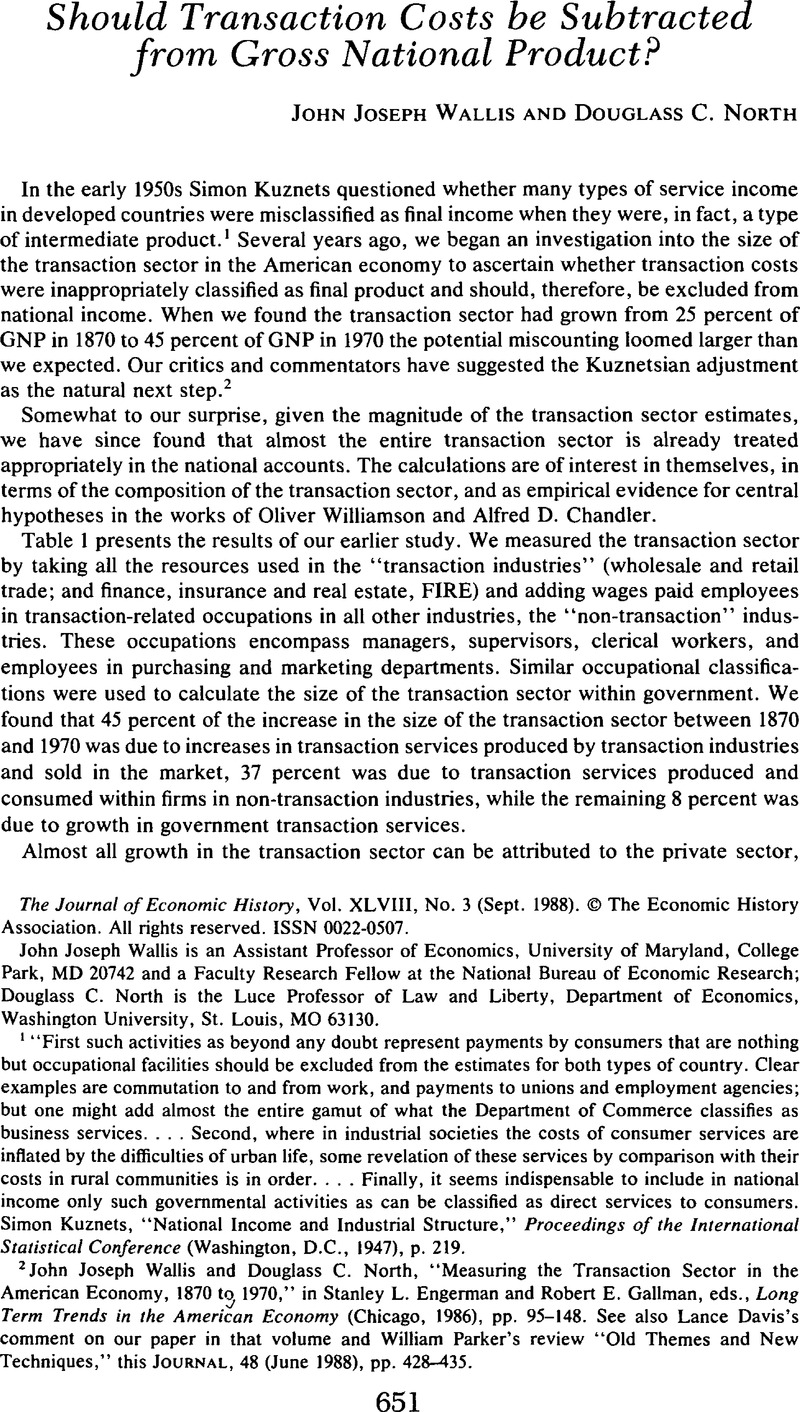Published online by Cambridge University Press: 03 March 2009

John Joseph Wallis is an Assistant Professor of Economics, University of Maryland, College Park, MD 20742 and a Faculty Research Fellow at the National Bureau of Economic Research; Douglass C. North is the Luce Professor of Law and Liberty, Department of Economics, Washington University, St. Louis, MO 63130.
1 “First such activities as beyond any doubt represent payments by consumers that are nothing but occupational facilities should be excluded from the estimates for both types of country. Clear examples are commutation to and from work, and payments to unions and employment agencies; but one might add almost the entire gamut of what the Department of Commerce classifies business services.…Second, where in industrial societies the costs of consumer services are inflated by the difficulties of urban life, some revelation of these services by comparison with their costs in rural communities is in order. … Finally, it seems indispensable to include in national income only such governmental activities as can be classified as direct services to consumers. Kuznets, Simon, “National Income and Industrial Structure,” Proceedings of the International Statistical Conference (Washington, D.C., 1947), p. 219.Google Scholar
2 Wallis, John Joseph and North, Douglass C., “Measuring the Transaction Sector in the American Economy, 1870 to 1970,” in Engerman, Stanley L. and Gallman, Robert E., eds., Long Term Trends in the American Economy (Chicago, 1986), pp. 95–148.Google Scholar See also Davis, Lance's comment on our paper in that volume and Parker, William's review “Old Themes and New Techniques,” this JOURNAL, 48 (06 1988), pp. 428–435.Google Scholar
3 In our earlier estimates the total output (intermediate and final product) of the transaction industries was included in the transaction sector, since the transaction services produced in the non-transaction industries were attributed only to labor employed in those industries (i.e., intermediate inputs purchased from the transaction industries were attributed to the transaction industries in our estimates in Table 1). The 40 percent figure was derived by taking total industry output for wholesale and retail trade, finance and insurance, and real estate from the input-output tables for 1972 from U.S. Department of Commerce, Survey of Current Business, 59 04 1979), pp. 67–68;Google Scholar and deducting from that gross housing output from U.S. Department of Commerce, National Income and Product Accounts of the United States, 1929–1976 (Washington, D.C., 1981). The estimate for total non-rental industry output was $376,351 million. Intermediate products from those industries totaled $150,075 million (Survey of Current Business, p. 68) or 39.88 percent of total industry output.Google Scholar
4 Assuming that 40 percent of output in trade and FIRE in 1870 was intermediate product is problematic, but there is no obvious way to generate an estimate. Substantially different assumptions, however, (say 20 or 60 percent) would not change the conclusion of this note.
5 From the bottom panel of Table 1 we can see that in 1970 the transaction industires make up 65 percent of the transaction sector and that the non-transaction industries make up 22 percent. Assuming that 60 percent of the output from transaction industries is final product and that 20 percent of the output from non-transaction industries is distributed directly to consumers, nad that government distributed no goods to cnsumers we get: (.65 × 0.6) + (0.22 × 0.2) =. 434. The 20 percent figure comes from Bargre, who estimates that 20 percent of all commodities were distributed directly by firms to consumers in 1948. Barger, Harold, Distribution's Place in hte American Economy since 1869 (Princeton, 1955), p. 22.Google Scholar
6 Parker, , “Old Themes and New Techniques,” p. 433.Google Scholar
7 Williamson, Oliver, The Economic Institutions of Capitalism (New York, 1986);Google Scholar and Chandler, Alfred D. Jr, The Visible Hand (Cambridge, 1977).Google Scholar